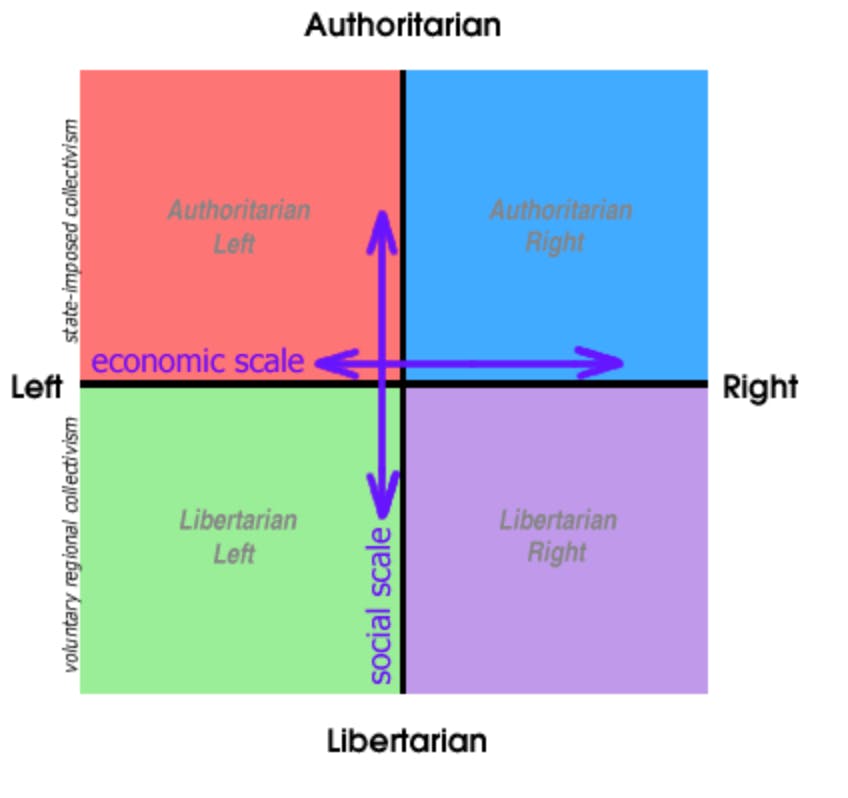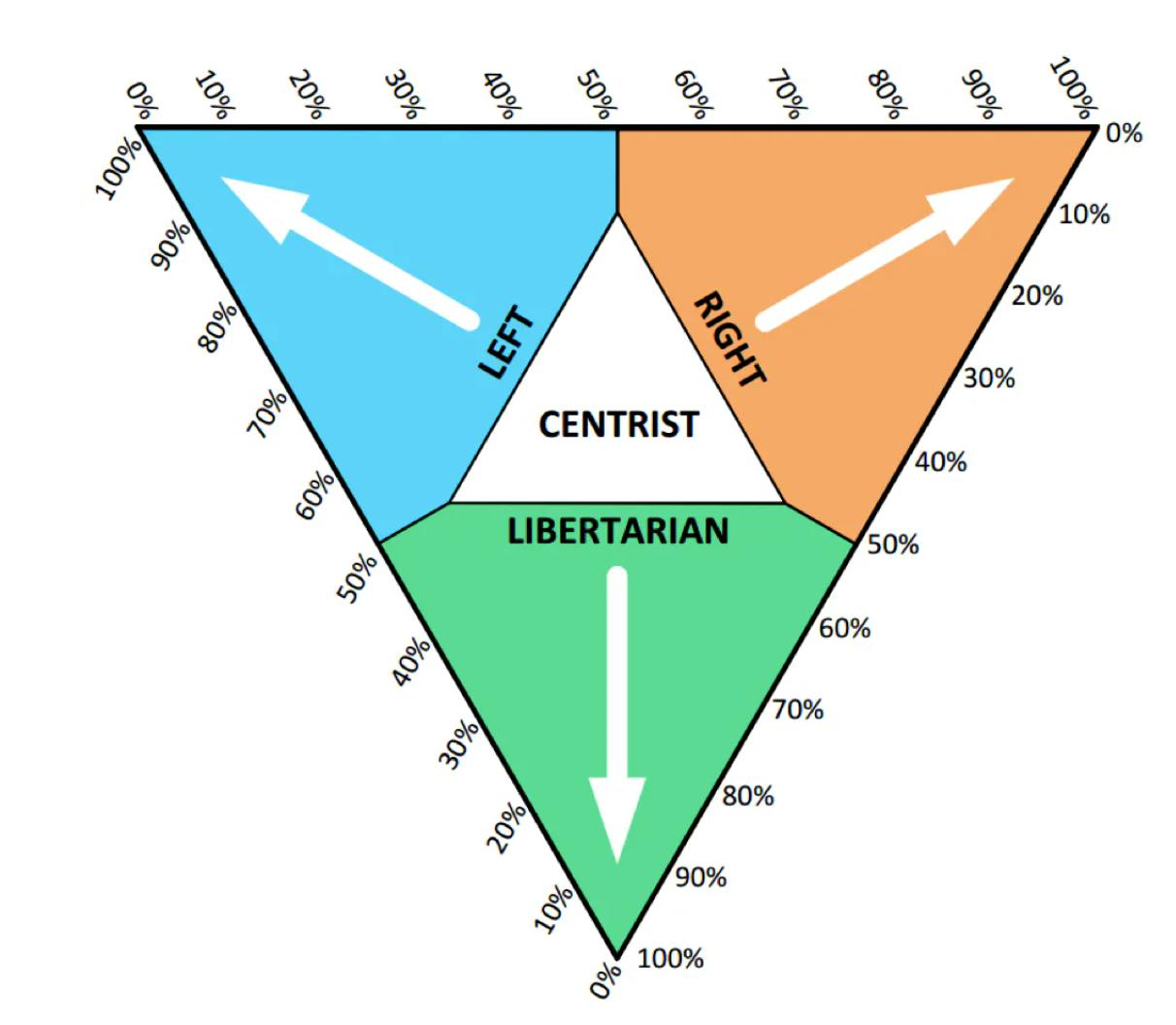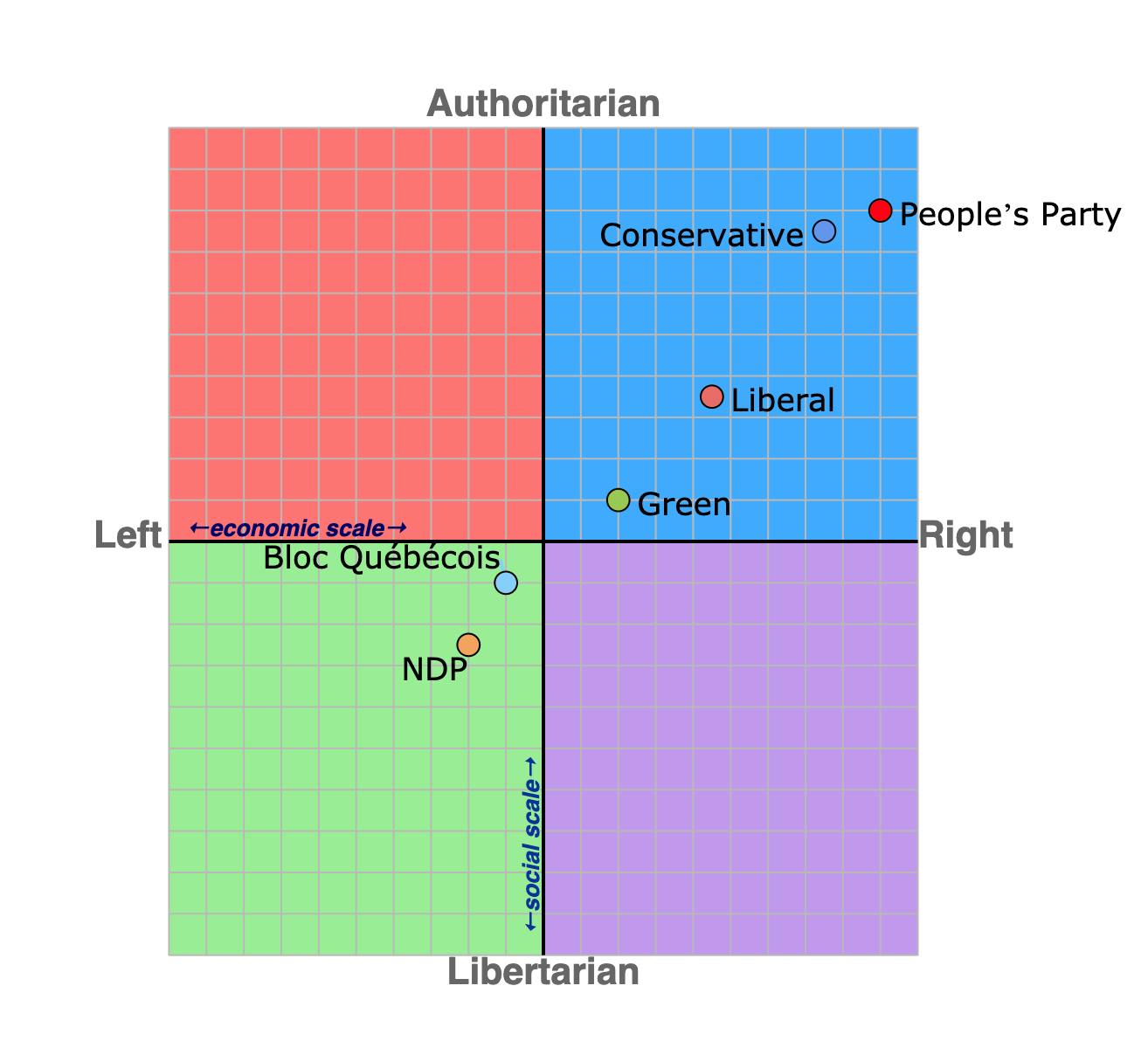Political Compass
What is the Political Compass?
The Political Compass suggests that instead of a single-axis understanding of politics, ideologies are better measured on two separate axes: a right/left economic axis and an authoritarian/libertarian axis.

The Basic Idea
When asked about your political views, you may answer by saying that you are left-wing or right-wing. Often, these terms seem synonymous with being either liberal or being conservative; but should the concepts really be equated?
The U.S. electoral landscape is more polarized than ever, with divisions between those that identify as liberals and those that identify as conservative. One of the reasons behind political polarization may be because of an understanding of synonymity between left-wing and liberal, and right-wing and conservative. This popular single-axis understanding of politics can cause people to feel as though they have to choose a side, and then must follow the norms of that side. When politics are characterized and represented on a right/left geometrical axis, it is no wonder that the nation is more divided than ever.
1
A single-axis model conflates liberal and conservative ideologies with right-wing and left-wing stances, excluding the nuances that can exist in someone’s political ideals. Single-axis models like the right/left-wing divide have been criticized for being too simple and reductionist, and it has been suggested that the right/left divide only captures economic issues but that it need not be reflective of one’s social political identity.2 Instead of having to have left-wing mean liberal and right-wing mean conservative, the political compass proposes that we are better off measuring political ideologies on two separate axes: a right/left economic axis and an authoritarian/libertarian axis.3 With such a model, it would be possible for someone to be right-wing and libertarian, or left-wing and authoritarian; none of the views are made mutually exclusive with another. The political compass proposes this alternative model because research has suggested that one’s economic views do not always align with their overall political identity, and therefore, the model would allow people to more accurately understand where they stand in relation to other views, which could mean a less polarized political landscape.
The social dimension is also important in politics. That’s the one that the mere left-right scale doesn’t adequately address. So we’ve added one, ranging in positions from extreme authoritarian to extreme libertarian […] [b]oth an economic dimension and a social dimension are important factors for a proper political analysis.1
- Dan Ariely, The Upside of Irrationality: The Unexpected Benefits of Defying Logic at Work and at Home
Theory, meet practice
TDL is an applied research consultancy. In our work, we leverage the insights of diverse fields—from psychology and economics to machine learning and behavioral data science—to sculpt targeted solutions to nuanced problems.
Key Terms
Left-Wing: Left-wing political ideologies are characterized by more progressive views. Since the political compass asks us to isolate the left/right binary for economic preferences, left-wing economic policy often favors higher taxes for wealthy individuals, stronger regulations for businesses, and government spending on social infrastructure.4
Right Wing: Right-wing political ideologies are characterized by conservative views. Since the political compass asks us to isolate the left/right binary for economic preferences, right-wing economic policy often favors reducing taxes, limiting government spending, and fewer government-imposed restrictions on businesses.
Authoritarian: People who support authoritarianism often believe that the state is more important than the individual, and therefore, that authorities are necessary and should be respected. An authoritarian system places power in the hands of a few individual elites that ask all others to comply with their laws and policies.5
Libertarian: People that hold a libertarian political identity often focus on the freedom of the individual. They believe that personal freedom should be maximized and they support the idea that government authority and control over their citizens should be displaced.5 Equality is of utmost importance for libertarians.
History
Historically, a vast amount of political analysis has tried to understand political stances based solely on a single-axis model of ‘left’ and ‘right’. This axis as a tool of political representation dates back to 18th century France. It refers to the seating arrangements of political members at the National Assembly who were trying to write a new constitution for France, with one of the main issues being how much power the king should have.6 Those that believed he should have a lot of power sat on the right, and those that did not sat on the left. Since people had to physically either sit on the right or the left, it is easy to understand why a binary was created that sorted all political preferences as either right or left and associated these views with where your views aligned with authority.
However, as time has gone on, the single-axis political model has been criticized for being too simplistic. Various social scientists have grappled with how to come up with more accurate models that can capture the modern political climate, most opting to add another axis to their models.
In the 1950s, psychologists Leonard Ferguson and Hans Eysenck both individually suggested that double-axis, two-dimensional graphs were more fitting for understanding the political spectrum that existed.7 These theories understood political identities as being reflective of personalities rather than just economic preferences. In particular, Hans Eysenck’s model, as seen above, is similar to the political compass model, especially in its innovative move that did not place fascism as the opposite of communism, contrary to popular belief, but instead that fascism was the opposite anarchism. The political compass is rooted in similar beliefs, but places authoritarianism as the opposite of libertarian, and uses left and right instead of radical and conservative.
The political compass was later popularized, in 2000, by an online quiz that asked people to answer to what extent they agreed with 62 different statements that were supposed to reveal their political views and identity. After completing the quiz, people were given their position on a chart, as shown below,3 with both an economic and social dimension.

People
Theodor Adorno
The political compass was influenced by theories of personality proposed by Theodor Adorno.8 Before Adorno’s book The Authoritarian Personality, fascism, a political regime that exalts the nation over the individual to an extreme degree,9 was viewed as a purely political phenomenon. Adorno instead suggested that fascism had its roots in the psyche and was correlated to personality. The political compass builds on the idea of political personalities and identities which necessitates the second authoritarian/libertarian social scale.
Wayne Brittenden
Wayne Brittenden is responsible for popularizing the ideas behind the political compass. He is a journalist who owns the mysterious New-Zealand based organization Pace News Limited that created the quiz aforementioned.10 On the website, Brittenden explains the inadequacies of a single right/left axis for describing the political spectrum and invites people to find out where they land on a double-axis chart. After getting your results, you also can compare your position to that of important political leaders.3
Consequences
The political compass opens up the political spectrum by expanding upon Adorno’s theorization of political personalities. These days, political identity is often seen as more important than differences in opinion of economic policy. In this time of blurred distinction between left/right-wing economic policies, the social scale is of utmost importance to understand the political landscape. The political compass is able to take political personality and identity into account when charting people’s position on a spectrum.
The political compass does not just reveal one’s own position but also allows for comparison with popular political leaders. This is important because the chart almost always places influential leaders in the authoritarian right quadrant, whilst popular opinion would suggest that most people see themselves in the opposite quadrant.8 By demonstrating this gap between the public’s position on the chart and the position of their political leaders, the political compass can have serious implications that suggest that people’s personal political values may not correspond to the values of their leaders.8 The political compass can thereby potentially help explain why many people feel alienated from politics and why we may hold a negative view on the trajectory of our society.
By giving people a more accurate idea of where they stand in relation to political leaders, the political compass may help people vote for leaders that more closely share their personal values which could lead to a society that is happier with their political stance.
Controversies
The political compass quiz has been criticized for being too simple and for not clearly explaining its methodology, making it difficult to understand how it determines one’s position on the chart. 8 It is unclear what objective measures the political compass uses to determine how your opinions match up with left, right, authoritarian, or libertarian ideologies, which also makes you wonder how it determined the position of influential leaders who did not answer their 62 statements. Definitions of what counts as authoritarian or libertarian have also changed over the years, and without explaining what each one is defined as for the purpose of the quiz, it could be that they no longer accurately correspond to today’s understanding of each political personality. The terms ‘left’ and ‘right’ come from 18th century France, and research has shown that many people don’t actually have well-defined ideas of what the terms mean outside of their connection to authoritarianism or libertarianism.12 In order to be more fruitful, and allow for its validity to be determined, the political compass would need better-defined variables.
Additionally, many people who have taken the quiz have found that their position is further to the left and more libertarian than they would have assumed.8 While it leaves room for people to be left-wing and authoritarian, few people have found that this is where they get matched up. It may suggest that these positions are possible, but if no one exists in these positions, they may serve no real purpose. We have to question whether anyone really exists that is extremely left-wing in their economic views but authoritarian, or if anyone really exists that is extremely right-wing in their economic views but libertarian.12
Although more nuanced than single-axis models of the political spectrum, some people believe that a triangular model is better fitting than a Cartesian graph, such as the one below:12

Case Study
In order to understand the way in which the political compass may more accurately represent people’s political ideologies when there is a greater consensus about neoliberal economic policy, it is useful to examine how the political compass has tracked voters’ positions in past elections.

The 2019 Canadian Election
The image below tracks where the political compass places people on the chart in relation to their liberal party.3 The graph follows the idea that people are more aligned with their views on economic policy, with most parties falling in the right-wing economic axis. A single-axis model would be much more likely to place liberal and green parties to the left, suggesting that this model may in fact be too simplistic for today’s complex political landscape.
Interestingly, the liberal party is found in the authoritarian quadrant, although still less authoritarian than the conservative party. What the political compass may indicate is how Justin Trudeau, the liberal party leader, was successful; he represented a ‘middle-way’ that more people could get on board with.3 Even though Andrew Sheer, the former Conservative party leader, had said that his party is neither left nor right, the chart demonstrates that the liberal party was better able to find the middle ground.3
Moreover, circulating this graph may allow for voters to feel more comfortable voting for who their views actually align with, instead of just following a traditional understanding of each political party. Since the website both provides insight into the position of influential leaders and political parties and allows you to determine your own position, it could mean that people feel more comfortable voting for a new party, since their choice is not as binary as a single-axis model suggests.
Related Content
Is a Biased Vote Better Than No Vote?
In this article, TDL writer Sanketh Andhavarapu examines the biases that influence voting behavior. He describes how the status-quo bias and regret avoidance often cause individuals to either keep things the same, or not vote at all. Andhavarapu suggests that voters need to be more politically aware in their political decisions, or else their vote may actually make things worse. A possible tool for increasing political awareness could be the political compass, which allows people to easily find out where they stand in relation to party leaders.
Sources
- Harman, J. C. (2018). The psychological spectrum: Political orientation and its origins in perception and culture. Undergraduate Journal of Politics and International Relations, 1(1). https://doi.org/10.22599/ujpir.25
- Otjes, S. (2017). What’s left of the left–right dimension? Why the economic policy positions of Europeans do not fit the left–right dimension. Social Indicators Research, 136(2), 645-662. https://doi.org/10.1007/s11205-017-1575-7
- The Political Compass. (n.d.). Retrieved October 26, 2020, from https://www.politicalcompass.org/
- Diffen. (n.d.). Left Wing vs. Right Wing. Retrieved October 26, 2020, from https://www.diffen.com/difference/Left_Wing_vs_Right_Wing
- Encyclopedia Britannica. (2017, November 2). Authoritarianism. https://www.britannica.com/topic/authoritarianism
- Carlisle, M. (2019, September 12). What to Know About the Origins of ‘Left’ and ‘Right’ in Politics, From the French Revolution to the 2020 Presidential Race. Time. https://time.com/5673239/left-right-politics-origins/
- Cox, G. (2012, November 28). Left, right, up, down. New Scientist. https://www.newscientist.com/letter/mg21628930-500-left-right-up-down/
- Fogg, A. (2017, May 8). Political Compass points to alienation. the Guardian. https://www.theguardian.com/commentisfree/2010/apr/12/political-compass-voter-alienation
- Merriam-Webster. (n.d.). Definition of fascism. Dictionary by Merriam-Webster. Retrieved October 26, 2020, from https://www.merriam-webster.com/dictionary/fascism
- Open Corporates. (n.d.). Pace News Limited. Retrieved October 26, 2020, from https://opencorporates.com/companies/nz/115591
- Mills, S. (2019, July 30). But, what is neoliberalism? Medium. https://medium.com/swlh/but-what-is-neoliberalism-41f0d8e30695
- Kastelein, N. (2018, October 17). The other right: What’s wrong with the Political Compass. The Spectator Australia. https://www.spectator.com.au/2018/10/the-other-right-whats-wrong-with-the-political-compass/



